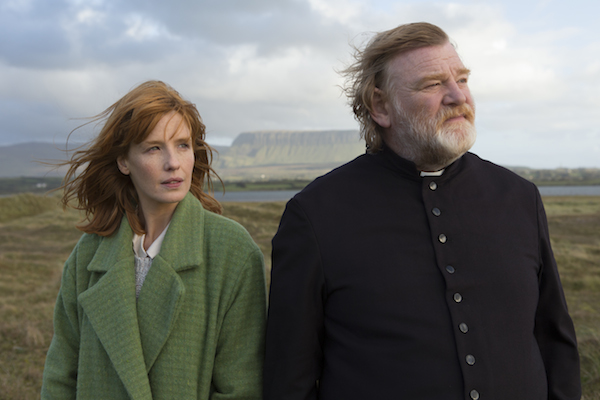Movie review by Greg Carlson
Father James Lavelle (Brendan Gleeson) receives the startling news in confession that he is to be murdered in one week – not for anything Lavelle has or has not done, but because the damaged soul on the other side of the sliding lattice insists that “There’s no point in killing a bad priest, but killing a good one… That’d be a shock.” The unseen man who condemns Lavelle is known to the clergyman but not to the viewer, a tactic that allows writer-director John Michael McDonagh to trot out a gallery of weirdoes, malcontents, non-believers, adulterers, and abusers functioning as potential suspects while Lavelle “puts his house in order” and the hours tick by.
“Calvary” is the second screen collaboration between McDonagh and Gleeson, and the veteran actor provides a measure of stability and calm in a movie that regularly shifts from black comedy to serious contemplation. McDonagh’s ambitions are abundant, but the filmmaker is happy to apply the hammer when a scalpel might have been more effective. Lavelle, who opts not to take any real precautions against his imminent demise, is burdened by the weight of the widespread sexual abuse and rape of vulnerable minors, but as David Edelstein notes, the scope of charges could be expanded to include the “corruption, impotence, and general irrelevance of the Catholic Church.”
Lavelle is by most accounts a good and decent man. We learn that he joined the priesthood after the death of his wife, leaving their young daughter (played as a grown-up by Kelly Reilly) with the devastating feeling that she’d lost both her parents. Reilly’s Fiona, visiting her dad’s village following a suicide attempt, brings a much-needed female perspective to “Calvary.” The only other women to interact with Lavelle are a grieving widow and a local cheating on her spouse. McDonagh’s decision to give Lavelle a daughter – and the marriage and sexual knowledge of his former life – humanizes the friar by distancing him from the “celibates” who preyed on children and by suggesting to the community members that Lavelle is “one of them.”
There is something off-balance, however, about the way in which McDonagh imagines Lavelle going about his business after someone he knows makes a threat against his life. Surely, audience members are being invited to size up the possible killer-to-be, and many will wonder why Lavelle doesn’t bother to confront him earlier. McDonagh, in an interview with Helen O’Hara, acknowledges that he set out to “kind of rip off the Hitchcock ‘I Confess’ structure” as well as utilize a “Who’s going to do it?” variation on Agatha Christie-style formula.
In his somewhat anachronistic soutane, Lavelle defies the stereotype of the contemporary Catholic priest, and McDonagh has claimed that the stark costume calls to mind both the iconographic look of figures in Sergio Leone films and the “Samurai warrior putting their armour on every day to go out to battle the forces of darkness.” In the end, and especially in the movie’s grim climax, “Calvary” fails to attain the level of insight and transcendence that might have been present in a story with richer characterizations among the supporting cast and fewer manipulations by the filmmaker. McDonagh’s fascination with sinners, however, never lacks for color.
